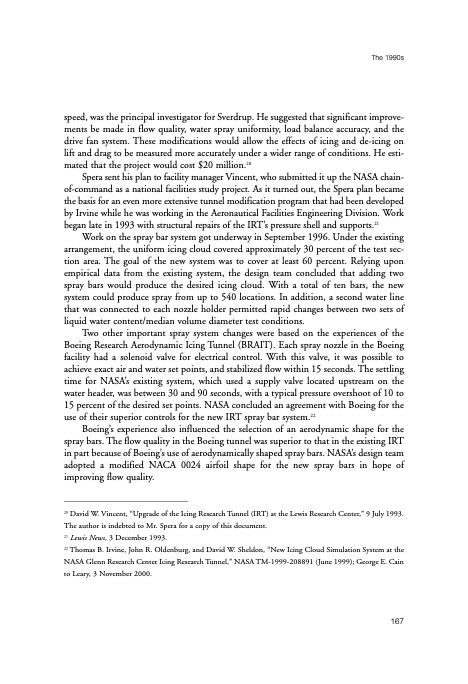
PDF Publication Title:
Text from PDF Page: 178
speed, was the principal investigator for Sverdrup. He suggested that significant improve- ments be made in flow quality, water spray uniformity, load balance accuracy, and the drive fan system. These modifications would allow the effects of icing and de-icing on lift and drag to be measured more accurately under a wider range of conditions. He esti- mated that the project would cost $20 million.20 Spera sent his plan to facility manager Vincent, who submitted it up the NASA chain- of-command as a national facilities study project. As it turned out, the Spera plan became the basis for an even more extensive tunnel modification program that had been developed by Irvine while he was working in the Aeronautical Facilities Engineering Division. Work began late in 1993 with structural repairs of the IRT’s pressure shell and supports.21 Work on the spray bar system got underway in September 1996. Under the existing arrangement, the uniform icing cloud covered approximately 30 percent of the test sec- tion area. The goal of the new system was to cover at least 60 percent. Relying upon empirical data from the existing system, the design team concluded that adding two spray bars would produce the desired icing cloud. With a total of ten bars, the new system could produce spray from up to 540 locations. In addition, a second water line that was connected to each nozzle holder permitted rapid changes between two sets of liquid water content/median volume diameter test conditions. Two other important spray system changes were based on the experiences of the Boeing Research Aerodynamic Icing Tunnel (BRAIT). Each spray nozzle in the Boeing facility had a solenoid valve for electrical control. With this valve, it was possible to achieve exact air and water set points, and stabilized flow within 15 seconds. The settling time for NASA’s existing system, which used a supply valve located upstream on the water header, was between 30 and 90 seconds, with a typical pressure overshoot of 10 to 15 percent of the desired set points. NASA concluded an agreement with Boeing for the use of their superior controls for the new IRT spray bar system.22 Boeing’s experience also influenced the selection of an aerodynamic shape for the spray bars. The flow quality in the Boeing tunnel was superior to that in the existing IRT in part because of Boeing’s use of aerodynamically shaped spray bars. NASA’s design team adopted a modified NACA 0024 airfoil shape for the new spray bars in hope of improving flow quality. The 1990s 20 David W. Vincent, “Upgrade of the Icing Research Tunnel (IRT) at the Lewis Research Center,” 9 July 1993. The author is indebted to Mr. Spera for a copy of this document. 21 Lewis News, 3 December 1993. 22 Thomas B. Irvine, John R. Oldenburg, and David W. Sheldon, “New Icing Cloud Simulation System at the NASA Glenn Research Center Icing Research Tunnel,” NASA TM-1999-208891 (June 1999); George E. Cain to Leary, 3 November 2000. 167PDF Image | History of NASA Icing Research Tunnel

PDF Search Title:
History of NASA Icing Research TunnelOriginal File Name Searched:
sp4226.pdfDIY PDF Search: Google It | Yahoo | Bing
NFT (Non Fungible Token): Buy our tech, design, development or system NFT and become part of our tech NFT network... More Info
IT XR Project Redstone NFT Available for Sale: NFT for high tech turbine design with one part 3D printed counter-rotating energy turbine. Be part of the future with this NFT. Can be bought and sold but only one design NFT exists. Royalties go to the developer (Infinity) to keep enhancing design and applications... More Info
Infinity Turbine IT XR Project Redstone Design: NFT for sale... NFT for high tech turbine design with one part 3D printed counter-rotating energy turbine. Includes all rights to this turbine design, including license for Fluid Handling Block I and II for the turbine assembly and housing. The NFT includes the blueprints (cad/cam), revenue streams, and all future development of the IT XR Project Redstone... More Info
Infinity Turbine ROT Radial Outflow Turbine 24 Design and Worldwide Rights: NFT for sale... NFT for the ROT 24 energy turbine. Be part of the future with this NFT. This design can be bought and sold but only one design NFT exists. You may manufacture the unit, or get the revenues from its sale from Infinity Turbine. Royalties go to the developer (Infinity) to keep enhancing design and applications... More Info
Infinity Supercritical CO2 10 Liter Extractor Design and Worldwide Rights: The Infinity Supercritical 10L CO2 extractor is for botanical oil extraction, which is rich in terpenes and can produce shelf ready full spectrum oil. With over 5 years of development, this industry leader mature extractor machine has been sold since 2015 and is part of many profitable businesses. The process can also be used for electrowinning, e-waste recycling, and lithium battery recycling, gold mining electronic wastes, precious metals. CO2 can also be used in a reverse fuel cell with nafion to make a gas-to-liquids fuel, such as methanol, ethanol and butanol or ethylene. Supercritical CO2 has also been used for treating nafion to make it more effective catalyst. This NFT is for the purchase of worldwide rights which includes the design. More Info
NFT (Non Fungible Token): Buy our tech, design, development or system NFT and become part of our tech NFT network... More Info
Infinity Turbine Products: Special for this month, any plans are $10,000 for complete Cad/Cam blueprints. License is for one build. Try before you buy a production license. May pay by Bitcoin or other Crypto. Products Page... More Info
| CONTACT TEL: 608-238-6001 Email: greg@infinityturbine.com | RSS | AMP |